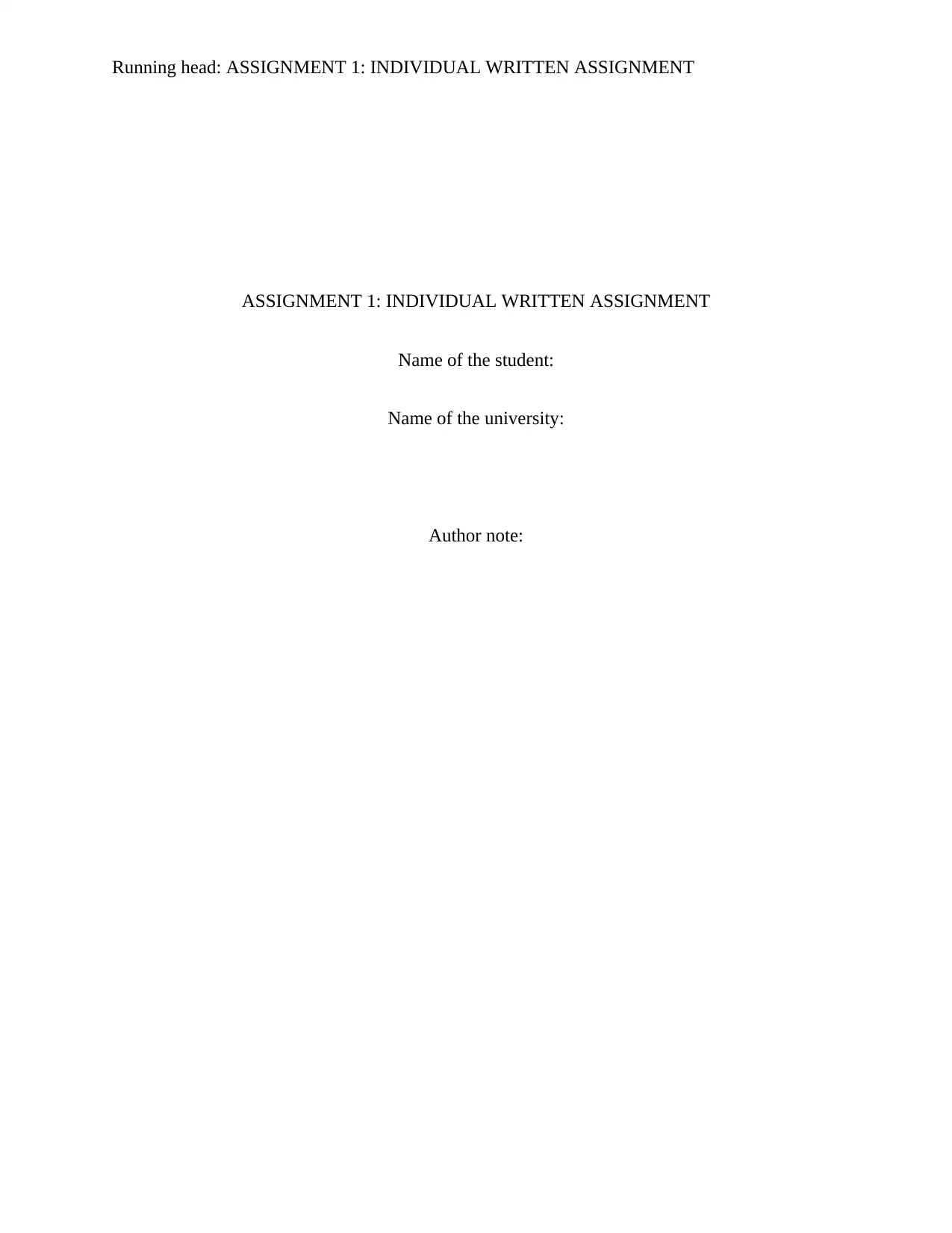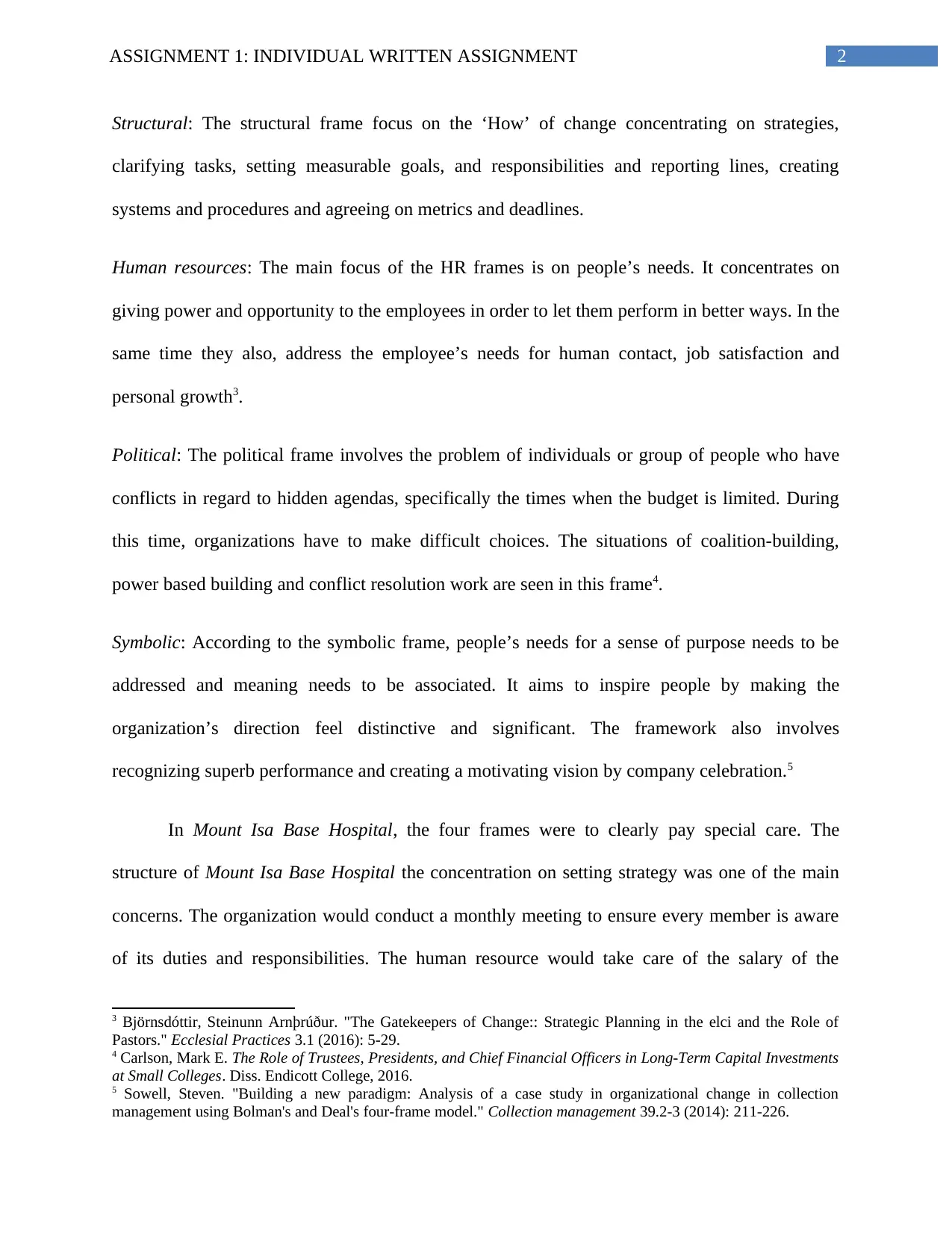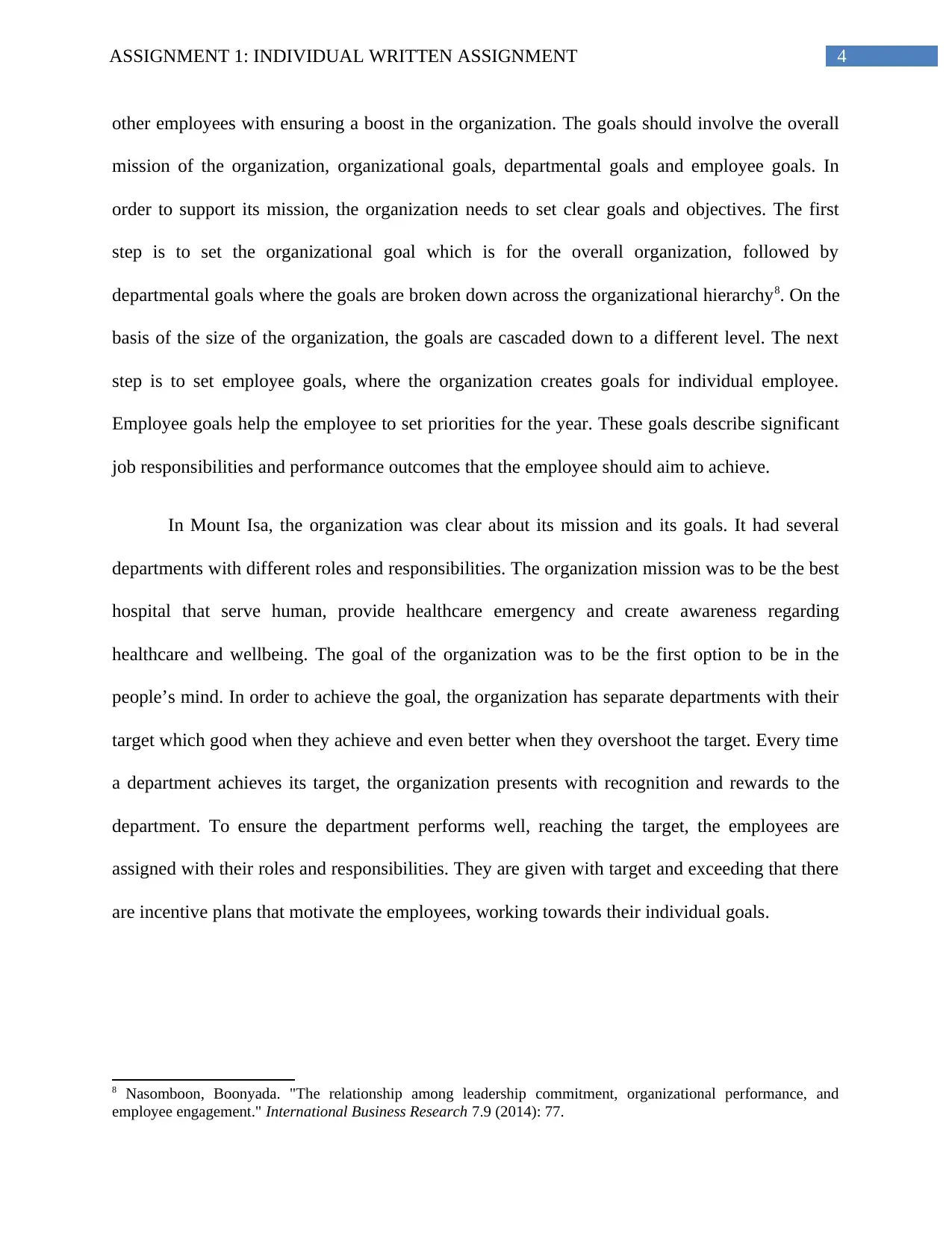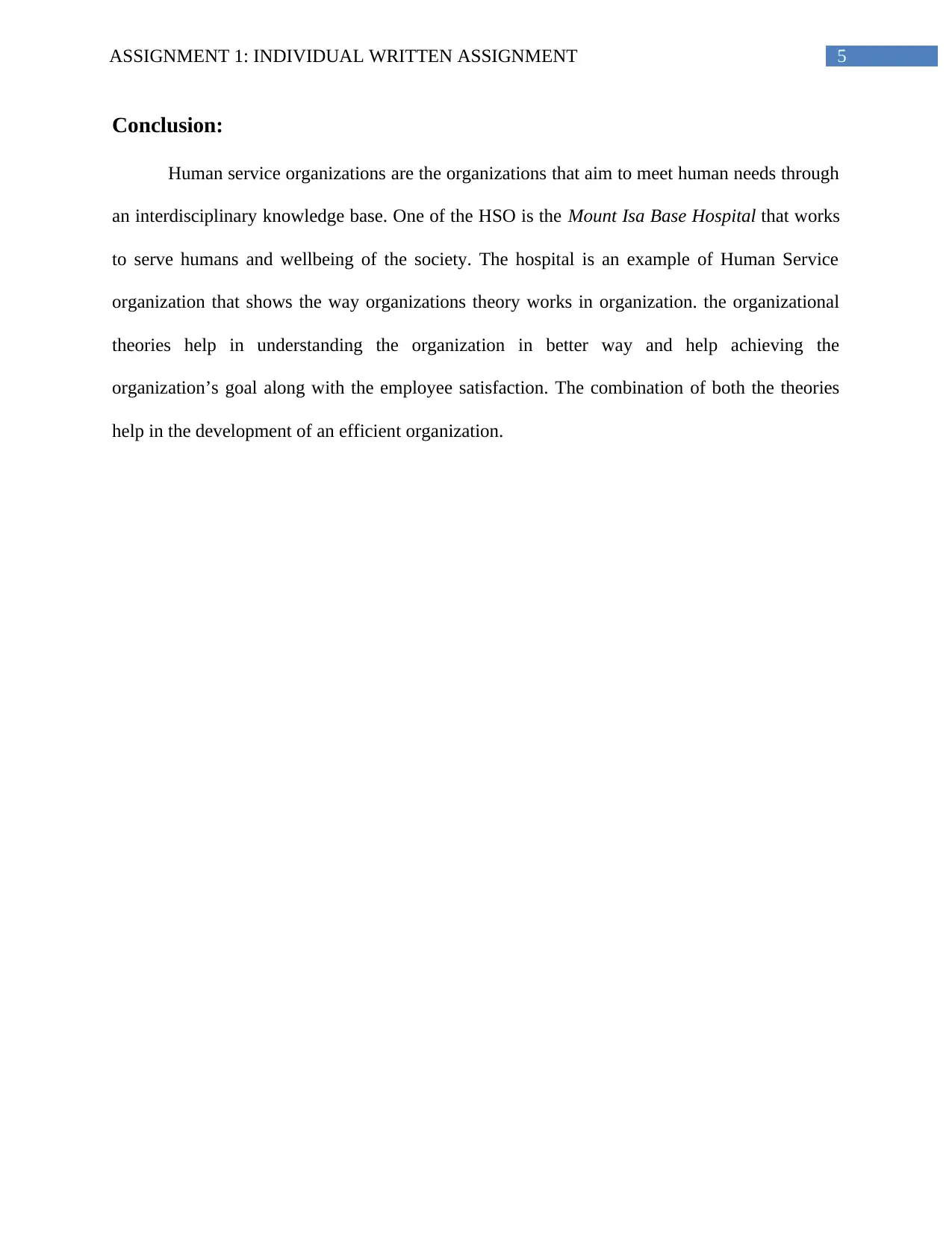Assignment 1: Individual HSO Analysis and Organizational Theories
VerifiedAdded on 2023/04/05
|8
|1593
|81
Report
AI Summary
This report presents an analysis of human service organizations (HSOs), focusing on the Mount Isa Base Hospital in Queensland, Australia. It applies two key organizational theories: Bolman and Deal's four-frame model (structural, human resource, political, and symbolic) and the importance of aligning organizational goals with employee goals. The report examines how the hospital's structure, human resources, political dynamics, and symbolic aspects contribute to its operations. It also discusses how the hospital aligns its mission and goals with departmental and employee objectives to improve performance and employee satisfaction. The analysis highlights the significance of organizational analysis skills for social work and the development of an efficient HSO.

Running head: ASSIGNMENT 1: INDIVIDUAL WRITTEN ASSIGNMENT
ASSIGNMENT 1: INDIVIDUAL WRITTEN ASSIGNMENT
Name of the student:
Name of the university:
Author note:
ASSIGNMENT 1: INDIVIDUAL WRITTEN ASSIGNMENT
Name of the student:
Name of the university:
Author note:
Paraphrase This Document
Need a fresh take? Get an instant paraphrase of this document with our AI Paraphraser

1ASSIGNMENT 1: INDIVIDUAL WRITTEN ASSIGNMENT
Introduction:
Human service organizations (HSO) are the organizations that aim to meet human needs
through an interdisciplinary knowledge base. They focus on the prevention of human problems
as well as remediation of problems along with maintaining a commitment in order to improve the
overall quality of human life of the service population1. The operations of these organizations are
critical and have various aspects to pay heed. In a similar aspect, the paper aims to discuss two
different organizational theories in order to examine an HSO. The HSO considered in this paper
is Mount Isa Base Hospital in Queensland, Australia. The paper also discusses the core principles
of relevant theories in order to critically examine the organization along with the importance of
organizational analysis skills for social work that are drawn from personal experience.
Theory 1:
In the book, Reframing organizations: artistry, choice and leadership (1991), Lee Bolman
and Terry Deal outlined a four-frame model. The model is widely known and used for
understanding organizational structure across the globe. The four perspectives are called
‘Frames’ by Bolman and Deal. According to Bolman and Deal, leaders need to look after the
organizational issues and look at the issues from four perspectives, working with only one
habitual frame will result in the leader's risk being ineffective2. The four frames of the Deal and
Bolman are 1. Structure 2. Human resource 3. Political and 4. Symbolic.
1 Almog-Bar, Michal, and Hillel Schmid. "Advocacy activities of nonprofit human service organizations: A critical
review." Nonprofit and voluntary sector quarterly 43.1 (2014): 11-35.
2 Fruehauf, Justin, Fahad Al-Khalifa, and Joseph Coniker. "USING THE BOLMAN AND DEAL'S FOUR
FRAMES IN DEVELOPING A DATA GOVERNANCE STRATEGY." Issues in Information Systems 16.2 (2015).
Introduction:
Human service organizations (HSO) are the organizations that aim to meet human needs
through an interdisciplinary knowledge base. They focus on the prevention of human problems
as well as remediation of problems along with maintaining a commitment in order to improve the
overall quality of human life of the service population1. The operations of these organizations are
critical and have various aspects to pay heed. In a similar aspect, the paper aims to discuss two
different organizational theories in order to examine an HSO. The HSO considered in this paper
is Mount Isa Base Hospital in Queensland, Australia. The paper also discusses the core principles
of relevant theories in order to critically examine the organization along with the importance of
organizational analysis skills for social work that are drawn from personal experience.
Theory 1:
In the book, Reframing organizations: artistry, choice and leadership (1991), Lee Bolman
and Terry Deal outlined a four-frame model. The model is widely known and used for
understanding organizational structure across the globe. The four perspectives are called
‘Frames’ by Bolman and Deal. According to Bolman and Deal, leaders need to look after the
organizational issues and look at the issues from four perspectives, working with only one
habitual frame will result in the leader's risk being ineffective2. The four frames of the Deal and
Bolman are 1. Structure 2. Human resource 3. Political and 4. Symbolic.
1 Almog-Bar, Michal, and Hillel Schmid. "Advocacy activities of nonprofit human service organizations: A critical
review." Nonprofit and voluntary sector quarterly 43.1 (2014): 11-35.
2 Fruehauf, Justin, Fahad Al-Khalifa, and Joseph Coniker. "USING THE BOLMAN AND DEAL'S FOUR
FRAMES IN DEVELOPING A DATA GOVERNANCE STRATEGY." Issues in Information Systems 16.2 (2015).

2ASSIGNMENT 1: INDIVIDUAL WRITTEN ASSIGNMENT
Structural: The structural frame focus on the ‘How’ of change concentrating on strategies,
clarifying tasks, setting measurable goals, and responsibilities and reporting lines, creating
systems and procedures and agreeing on metrics and deadlines.
Human resources: The main focus of the HR frames is on people’s needs. It concentrates on
giving power and opportunity to the employees in order to let them perform in better ways. In the
same time they also, address the employee’s needs for human contact, job satisfaction and
personal growth3.
Political: The political frame involves the problem of individuals or group of people who have
conflicts in regard to hidden agendas, specifically the times when the budget is limited. During
this time, organizations have to make difficult choices. The situations of coalition-building,
power based building and conflict resolution work are seen in this frame4.
Symbolic: According to the symbolic frame, people’s needs for a sense of purpose needs to be
addressed and meaning needs to be associated. It aims to inspire people by making the
organization’s direction feel distinctive and significant. The framework also involves
recognizing superb performance and creating a motivating vision by company celebration.5
In Mount Isa Base Hospital, the four frames were to clearly pay special care. The
structure of Mount Isa Base Hospital the concentration on setting strategy was one of the main
concerns. The organization would conduct a monthly meeting to ensure every member is aware
of its duties and responsibilities. The human resource would take care of the salary of the
3 Björnsdóttir, Steinunn Arnþrúður. "The Gatekeepers of Change:: Strategic Planning in the elci and the Role of
Pastors." Ecclesial Practices 3.1 (2016): 5-29.
4 Carlson, Mark E. The Role of Trustees, Presidents, and Chief Financial Officers in Long-Term Capital Investments
at Small Colleges. Diss. Endicott College, 2016.
5 Sowell, Steven. "Building a new paradigm: Analysis of a case study in organizational change in collection
management using Bolman's and Deal's four-frame model." Collection management 39.2-3 (2014): 211-226.
Structural: The structural frame focus on the ‘How’ of change concentrating on strategies,
clarifying tasks, setting measurable goals, and responsibilities and reporting lines, creating
systems and procedures and agreeing on metrics and deadlines.
Human resources: The main focus of the HR frames is on people’s needs. It concentrates on
giving power and opportunity to the employees in order to let them perform in better ways. In the
same time they also, address the employee’s needs for human contact, job satisfaction and
personal growth3.
Political: The political frame involves the problem of individuals or group of people who have
conflicts in regard to hidden agendas, specifically the times when the budget is limited. During
this time, organizations have to make difficult choices. The situations of coalition-building,
power based building and conflict resolution work are seen in this frame4.
Symbolic: According to the symbolic frame, people’s needs for a sense of purpose needs to be
addressed and meaning needs to be associated. It aims to inspire people by making the
organization’s direction feel distinctive and significant. The framework also involves
recognizing superb performance and creating a motivating vision by company celebration.5
In Mount Isa Base Hospital, the four frames were to clearly pay special care. The
structure of Mount Isa Base Hospital the concentration on setting strategy was one of the main
concerns. The organization would conduct a monthly meeting to ensure every member is aware
of its duties and responsibilities. The human resource would take care of the salary of the
3 Björnsdóttir, Steinunn Arnþrúður. "The Gatekeepers of Change:: Strategic Planning in the elci and the Role of
Pastors." Ecclesial Practices 3.1 (2016): 5-29.
4 Carlson, Mark E. The Role of Trustees, Presidents, and Chief Financial Officers in Long-Term Capital Investments
at Small Colleges. Diss. Endicott College, 2016.
5 Sowell, Steven. "Building a new paradigm: Analysis of a case study in organizational change in collection
management using Bolman's and Deal's four-frame model." Collection management 39.2-3 (2014): 211-226.
⊘ This is a preview!⊘
Do you want full access?
Subscribe today to unlock all pages.

Trusted by 1+ million students worldwide

3ASSIGNMENT 1: INDIVIDUAL WRITTEN ASSIGNMENT
employees, the time schedule, recruitment and other needs of the hospitals as well as the
employees of the hospital. Although the political frame of the hospital has some trouble, it would
be managed by the senior authorities. Since the town has a large aboriginal community there
were times when the aboriginals would seek healthcare which was faced with culture difference
difficulties. The hospital is working on these aspects for helping more aboriginals with
healthcare. Coming to the symbolic framework, every employee would find a strong sense of
purpose of saving lives and helping people. The purpose of the job in itself is a motivating factor
for the employees. Along with the strong purpose associated with the job role, the hospital also
created a motivating vision that would encourage good performance and help in recognizing the
company’s excellent performance.
Theory 2:
Aligning Organizational goal to employee goals: the organization’s goal is not only vital
for the organization but it plays a crucial role for the employees as well. The organization goal
must be aligned with employee goals. Connecting the strategic goals of an organization must
involve an employee’s performance goals6. An organization that is effectively aligned, it works
towards the same goal. Every employee is aware of their task and their job and the ways they can
contribute to the success of the overall organization. Goals of an organization have a purpose and
the direction toward which the entire organization works the entire year. Goals are predetermined
and describe the future result towards which the present efforts are directed. Every organization
understands the significance of setting goals7. However, it is not only the organization; everyone
understands the importance of setting a goal. Therefore, setting goals that are aligned with the
6 Ayers, Rebecca S. "Aligning individual and organizational performance: Goal alignment in federal government
agency performance appraisal programs." Public Personnel Management 44.2 (2015): 169-191.
7 De Clercq, Dirk, et al. "Unpacking the goal congruence–organizational deviance relationship: The roles of work
engagement and emotional intelligence." Journal of Business Ethics 124.4 (2014): 695-711.
employees, the time schedule, recruitment and other needs of the hospitals as well as the
employees of the hospital. Although the political frame of the hospital has some trouble, it would
be managed by the senior authorities. Since the town has a large aboriginal community there
were times when the aboriginals would seek healthcare which was faced with culture difference
difficulties. The hospital is working on these aspects for helping more aboriginals with
healthcare. Coming to the symbolic framework, every employee would find a strong sense of
purpose of saving lives and helping people. The purpose of the job in itself is a motivating factor
for the employees. Along with the strong purpose associated with the job role, the hospital also
created a motivating vision that would encourage good performance and help in recognizing the
company’s excellent performance.
Theory 2:
Aligning Organizational goal to employee goals: the organization’s goal is not only vital
for the organization but it plays a crucial role for the employees as well. The organization goal
must be aligned with employee goals. Connecting the strategic goals of an organization must
involve an employee’s performance goals6. An organization that is effectively aligned, it works
towards the same goal. Every employee is aware of their task and their job and the ways they can
contribute to the success of the overall organization. Goals of an organization have a purpose and
the direction toward which the entire organization works the entire year. Goals are predetermined
and describe the future result towards which the present efforts are directed. Every organization
understands the significance of setting goals7. However, it is not only the organization; everyone
understands the importance of setting a goal. Therefore, setting goals that are aligned with the
6 Ayers, Rebecca S. "Aligning individual and organizational performance: Goal alignment in federal government
agency performance appraisal programs." Public Personnel Management 44.2 (2015): 169-191.
7 De Clercq, Dirk, et al. "Unpacking the goal congruence–organizational deviance relationship: The roles of work
engagement and emotional intelligence." Journal of Business Ethics 124.4 (2014): 695-711.
Paraphrase This Document
Need a fresh take? Get an instant paraphrase of this document with our AI Paraphraser

4ASSIGNMENT 1: INDIVIDUAL WRITTEN ASSIGNMENT
other employees with ensuring a boost in the organization. The goals should involve the overall
mission of the organization, organizational goals, departmental goals and employee goals. In
order to support its mission, the organization needs to set clear goals and objectives. The first
step is to set the organizational goal which is for the overall organization, followed by
departmental goals where the goals are broken down across the organizational hierarchy8. On the
basis of the size of the organization, the goals are cascaded down to a different level. The next
step is to set employee goals, where the organization creates goals for individual employee.
Employee goals help the employee to set priorities for the year. These goals describe significant
job responsibilities and performance outcomes that the employee should aim to achieve.
In Mount Isa, the organization was clear about its mission and its goals. It had several
departments with different roles and responsibilities. The organization mission was to be the best
hospital that serve human, provide healthcare emergency and create awareness regarding
healthcare and wellbeing. The goal of the organization was to be the first option to be in the
people’s mind. In order to achieve the goal, the organization has separate departments with their
target which good when they achieve and even better when they overshoot the target. Every time
a department achieves its target, the organization presents with recognition and rewards to the
department. To ensure the department performs well, reaching the target, the employees are
assigned with their roles and responsibilities. They are given with target and exceeding that there
are incentive plans that motivate the employees, working towards their individual goals.
8 Nasomboon, Boonyada. "The relationship among leadership commitment, organizational performance, and
employee engagement." International Business Research 7.9 (2014): 77.
other employees with ensuring a boost in the organization. The goals should involve the overall
mission of the organization, organizational goals, departmental goals and employee goals. In
order to support its mission, the organization needs to set clear goals and objectives. The first
step is to set the organizational goal which is for the overall organization, followed by
departmental goals where the goals are broken down across the organizational hierarchy8. On the
basis of the size of the organization, the goals are cascaded down to a different level. The next
step is to set employee goals, where the organization creates goals for individual employee.
Employee goals help the employee to set priorities for the year. These goals describe significant
job responsibilities and performance outcomes that the employee should aim to achieve.
In Mount Isa, the organization was clear about its mission and its goals. It had several
departments with different roles and responsibilities. The organization mission was to be the best
hospital that serve human, provide healthcare emergency and create awareness regarding
healthcare and wellbeing. The goal of the organization was to be the first option to be in the
people’s mind. In order to achieve the goal, the organization has separate departments with their
target which good when they achieve and even better when they overshoot the target. Every time
a department achieves its target, the organization presents with recognition and rewards to the
department. To ensure the department performs well, reaching the target, the employees are
assigned with their roles and responsibilities. They are given with target and exceeding that there
are incentive plans that motivate the employees, working towards their individual goals.
8 Nasomboon, Boonyada. "The relationship among leadership commitment, organizational performance, and
employee engagement." International Business Research 7.9 (2014): 77.

5ASSIGNMENT 1: INDIVIDUAL WRITTEN ASSIGNMENT
Conclusion:
Human service organizations are the organizations that aim to meet human needs through
an interdisciplinary knowledge base. One of the HSO is the Mount Isa Base Hospital that works
to serve humans and wellbeing of the society. The hospital is an example of Human Service
organization that shows the way organizations theory works in organization. the organizational
theories help in understanding the organization in better way and help achieving the
organization’s goal along with the employee satisfaction. The combination of both the theories
help in the development of an efficient organization.
Conclusion:
Human service organizations are the organizations that aim to meet human needs through
an interdisciplinary knowledge base. One of the HSO is the Mount Isa Base Hospital that works
to serve humans and wellbeing of the society. The hospital is an example of Human Service
organization that shows the way organizations theory works in organization. the organizational
theories help in understanding the organization in better way and help achieving the
organization’s goal along with the employee satisfaction. The combination of both the theories
help in the development of an efficient organization.
⊘ This is a preview!⊘
Do you want full access?
Subscribe today to unlock all pages.

Trusted by 1+ million students worldwide

6ASSIGNMENT 1: INDIVIDUAL WRITTEN ASSIGNMENT
References:
Almog-Bar, Michal, and Hillel Schmid. "Advocacy activities of nonprofit human service
organizations: A critical review." Nonprofit and voluntary sector quarterly 43.1 (2014): 11-35.
Ayers, Rebecca S. "Aligning individual and organizational performance: Goal alignment in
federal government agency performance appraisal programs." Public Personnel
Management 44.2 (2015): 169-191.
Björnsdóttir, Steinunn Arnþrúður. "The Gatekeepers of Change:: Strategic Planning in the elci
and the Role of Pastors." Ecclesial Practices 3.1 (2016): 5-29.
Carlson, Mark E. The Role of Trustees, Presidents, and Chief Financial Officers in Long-Term
Capital Investments at Small Colleges. Diss. Endicott College, 2016.
De Clercq, Dirk, et al. "Unpacking the goal congruence–organizational deviance relationship:
The roles of work engagement and emotional intelligence." Journal of Business Ethics 124.4
(2014): 695-711.
Fruehauf, Justin, Fahad Al-Khalifa, and Joseph Coniker. "USING THE BOLMAN AND
DEAL'S FOUR FRAMES IN DEVELOPING A DATA GOVERNANCE STRATEGY." Issues
in Information Systems 16.2 (2015).
Nasomboon, Boonyada. "The relationship among leadership commitment, organizational
performance, and employee engagement." International Business Research 7.9 (2014): 77.
References:
Almog-Bar, Michal, and Hillel Schmid. "Advocacy activities of nonprofit human service
organizations: A critical review." Nonprofit and voluntary sector quarterly 43.1 (2014): 11-35.
Ayers, Rebecca S. "Aligning individual and organizational performance: Goal alignment in
federal government agency performance appraisal programs." Public Personnel
Management 44.2 (2015): 169-191.
Björnsdóttir, Steinunn Arnþrúður. "The Gatekeepers of Change:: Strategic Planning in the elci
and the Role of Pastors." Ecclesial Practices 3.1 (2016): 5-29.
Carlson, Mark E. The Role of Trustees, Presidents, and Chief Financial Officers in Long-Term
Capital Investments at Small Colleges. Diss. Endicott College, 2016.
De Clercq, Dirk, et al. "Unpacking the goal congruence–organizational deviance relationship:
The roles of work engagement and emotional intelligence." Journal of Business Ethics 124.4
(2014): 695-711.
Fruehauf, Justin, Fahad Al-Khalifa, and Joseph Coniker. "USING THE BOLMAN AND
DEAL'S FOUR FRAMES IN DEVELOPING A DATA GOVERNANCE STRATEGY." Issues
in Information Systems 16.2 (2015).
Nasomboon, Boonyada. "The relationship among leadership commitment, organizational
performance, and employee engagement." International Business Research 7.9 (2014): 77.
Paraphrase This Document
Need a fresh take? Get an instant paraphrase of this document with our AI Paraphraser

7ASSIGNMENT 1: INDIVIDUAL WRITTEN ASSIGNMENT
Sowell, Steven. "Building a new paradigm: Analysis of a case study in organizational change in
collection management using Bolman's and Deal's four-frame model." Collection
management 39.2-3 (2014): 211-226.
Sowell, Steven. "Building a new paradigm: Analysis of a case study in organizational change in
collection management using Bolman's and Deal's four-frame model." Collection
management 39.2-3 (2014): 211-226.
1 out of 8
Related Documents
Your All-in-One AI-Powered Toolkit for Academic Success.
+13062052269
info@desklib.com
Available 24*7 on WhatsApp / Email
![[object Object]](/_next/static/media/star-bottom.7253800d.svg)
Unlock your academic potential
Copyright © 2020–2025 A2Z Services. All Rights Reserved. Developed and managed by ZUCOL.

![Leadership Qualities Self Analysis Report - [University Name]](/_next/image/?url=https%3A%2F%2Fdesklib.com%2Fmedia%2Fimages%2Fgz%2F18fd87affd6949e69fb1fcec05fa0d86.jpg&w=256&q=75)



